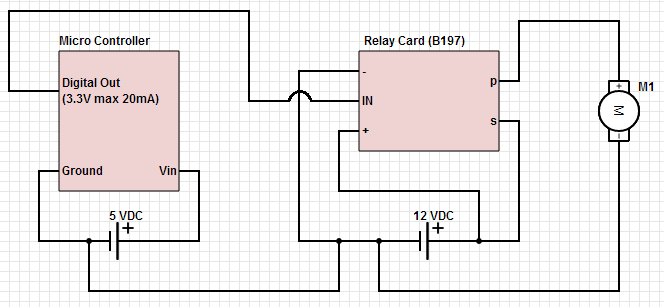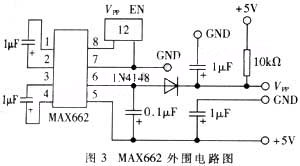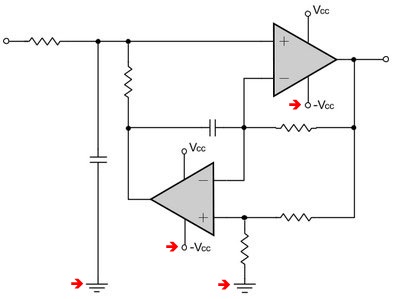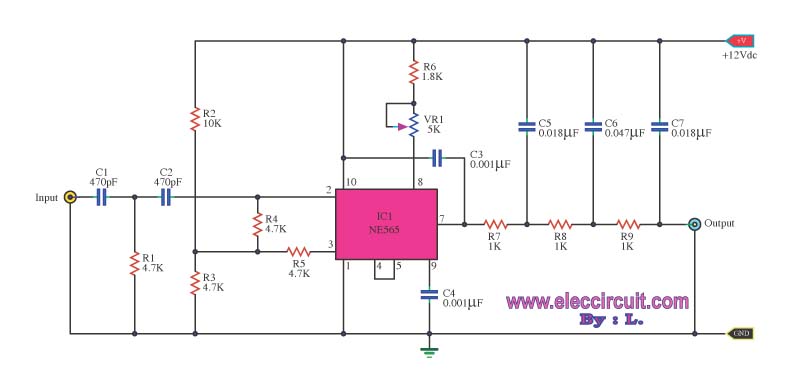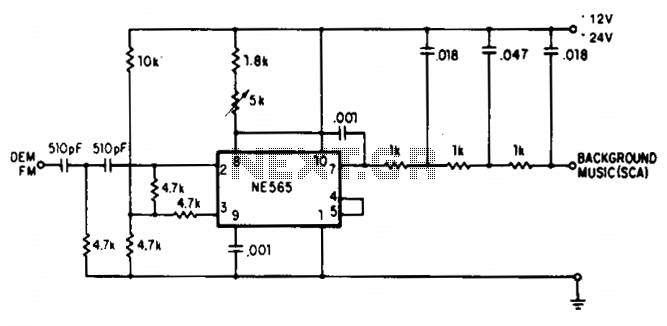
Eliminating Ground Loops
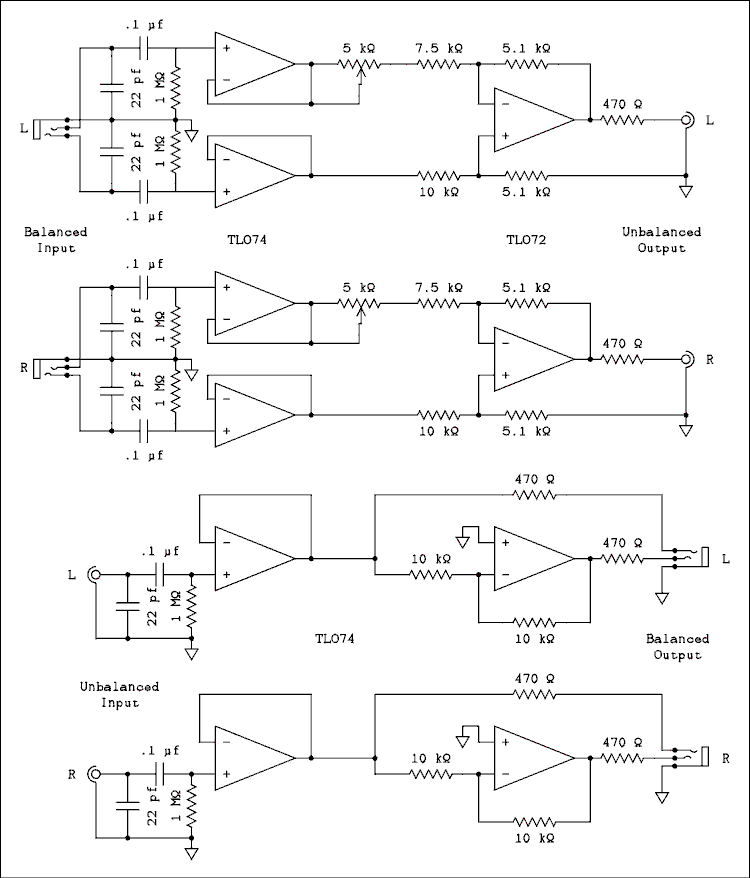
One of the most challenging issues in an audio system is the presence of ground loops. These loops not only introduce hum but can also pick up interference from electric drills, computer hardware, and even AM radio stations. Eliminating ground loops is often a complex task. The preamplifier and power amplifier are typically equipped with three-wire line cords and three-prong plugs. In this setup, the green wire in each line cord connects to the chassis of each unit, while the ground prong of each plug connects to the local power ground. The two chassis are interconnected through the shields of the audio cables, which are longer than depicted in the diagram. The shaded area in the illustration indicates the ground loop. This continuous loop extends from the preamp chassis to the power amplifier via the audio cable shields, from the power amplifier through the grounding wire of the line cord to the wall socket, and back to the preamp chassis.
Every tape deck typically comes with two stereo audio cables: one from the tape output on the preamp to the tape deck input, and the other from the tape deck output to the tape input on the preamp. This separation creates a ground loop, as shown in the shaded area of the figure. AC magnetic fields are present near power lines; thus, even in rural areas far from power lines, running a stereo and computer can still introduce AC fields. Using a generator would also generate AC magnetic fields through its wiring. When an AC field intersects a loop, it induces a current. If any part of the loop possesses resistance, a voltage drop occurs across it. Copper wire at room temperature has non-zero resistance, which means that the magnetic-induced current leads to a voltage drop across the audio cable shields, introducing hum in series with the audio signal.
Grounding the two chassis together with heavy wire may seem like a solution to short out the induced voltage; however, this approach can create another loop unless the wire is placed very close to the audio cable. Even if this is achieved, it may only reduce the hum's volume rather than eliminate it. Bringing line cords close together and near the audio cable is likely to increase the hum, as it places AC-carrying conductors in proximity to the audio cables, inducing more hum. The only reliable method to eliminate ground loops is to break the loop. Cutting the shields on the audio cable rarely resolves issues with unbalanced inputs due to the inevitable potential difference between the two chassis, even when grounded to the power line ground. This potential difference arises because the grounding wire experiences induced current from its close proximity to the line cord's current-carrying conductors.
In practical scenarios, disconnecting the power line ground from one of the chassis is not approved by electrical inspectors and is not necessary for home stereo equipment. Consumer-grade audio components are designed similarly to many power tools and small kitchen appliances, featuring double insulation that negates the need for a third wire safety ground. Conversely, professional and semi-professional audio equipment often includes a three-prong plug, accommodating the more demanding environments in which they operate. Such equipment typically has balanced inputs and outputs, providing an alternative method for addressing ground loops.
In summary, ground loops present significant challenges in audio systems, primarily caused by the interconnection of multiple components and the influence of AC magnetic fields. Solutions often involve breaking the loop rather than attempting to ground components together, especially in consumer-grade equipment designed with safety and functionality in mind.One of the most insidious problems in an audio system is one or more ground loops. They not only cause hum pickup, they can inject interference from electric drills, computer hardware and even AM radio stations. Eliminating them is often not a trivial procedure. Here are the causes of, and cures for, ground loops. Both the preamp and power amp are equipped with 3 wire line cords and 3 prong plugs. (Note: this is almost unheard of in home audio equipment. This example is given for illustration purposes only). The green wire in each line cord is connected to the chassis of each unit. The ground prong of each plug connects to the local power ground. The two chassis` are also connected together by the shields of the audio cable. The audio cables are much longer than indicated in the diagram. The shaded area shows the ground loop. As you can see there is a continuous loop from the preamp chassis to the power amp through the audio cable shields, from the power amp through the grounding wire of the line cord to the wall socket, and from the wall socket to the preamp chassis. Every tape deck I have ever bought has come supplied with two stereo audio cables. One goes from the tape output on the preamp to the tape deck input and the other goes from the tape deck`s output to the tape input on the preamp.
The separation between the two creates a ground loop as shown by the shaded area in the figure above. The cables are much longer than indicated by the diagram. There are AC magnetic fields everywhere there are power lines. If you live in the country far from any power lines you don`t have any AC fields but how do you run your stereo and computer Even if you were to use your own generator it, and its wiring, would cause AC magnetic fields.
Anytime an AC field cuts through a loop there is a current induced. if any part of the loop has resistance which is not zero there will be a voltage drop across it. Copper wire at room temperature has nonzero resistance and so the magnetic induced current causes a voltage drop across the shields of the audio cables placing a source of hum in series with the audio signal. You might try grounding the two chassis` together with very heavy wire in an attempt to short out the induced voltage.
The added wire will just create another loop unless you place it physically very close to the audio cable. Even if you do that all you will succeed in doing will be to reduce the volume of the hum but it will still be audible.
You might also try bringing the line cords close together and close to the audio cable but most likely all you will accomplish will be to increase the hum. You will place AC carrying conductors into close proximity with the audio cables thus inducing more hum than you are getting rid of.
The only sure way is to break the loop. Cutting the shields on the audio cable rarely works with unbalanced inputs. There will always be a potential difference between the two chassis` even though they are grounded to the power line ground. The reason is that the grounding wire gets a current induced in it because it is in such close proximity to the current carrying conductors of the line cord.
If this were a real situation, the only solution would be to somehow disconnect the power line ground from one of the chassis`. This is not approved by electrical inspectors and fortunately doesn`t need to be done in home stereo equipment.
Consumer grade sound components are made on the same principle as many power tools and small kitchen appliances. They are doubly insulated which eliminates the UL requirement for a third wire safety ground. Professional and semiprofessional audio gear is very likely to come with a 3 prong plug because of the more difficult environment in which it is used.
Such equipment also has balanced inputs and outputs which gives an alternative method of eliminating ground loops as will be discussed below. In the case illustrated in Fig 🔗 External reference
Every tape deck typically comes with two stereo audio cables: one from the tape output on the preamp to the tape deck input, and the other from the tape deck output to the tape input on the preamp. This separation creates a ground loop, as shown in the shaded area of the figure. AC magnetic fields are present near power lines; thus, even in rural areas far from power lines, running a stereo and computer can still introduce AC fields. Using a generator would also generate AC magnetic fields through its wiring. When an AC field intersects a loop, it induces a current. If any part of the loop possesses resistance, a voltage drop occurs across it. Copper wire at room temperature has non-zero resistance, which means that the magnetic-induced current leads to a voltage drop across the audio cable shields, introducing hum in series with the audio signal.
Grounding the two chassis together with heavy wire may seem like a solution to short out the induced voltage; however, this approach can create another loop unless the wire is placed very close to the audio cable. Even if this is achieved, it may only reduce the hum's volume rather than eliminate it. Bringing line cords close together and near the audio cable is likely to increase the hum, as it places AC-carrying conductors in proximity to the audio cables, inducing more hum. The only reliable method to eliminate ground loops is to break the loop. Cutting the shields on the audio cable rarely resolves issues with unbalanced inputs due to the inevitable potential difference between the two chassis, even when grounded to the power line ground. This potential difference arises because the grounding wire experiences induced current from its close proximity to the line cord's current-carrying conductors.
In practical scenarios, disconnecting the power line ground from one of the chassis is not approved by electrical inspectors and is not necessary for home stereo equipment. Consumer-grade audio components are designed similarly to many power tools and small kitchen appliances, featuring double insulation that negates the need for a third wire safety ground. Conversely, professional and semi-professional audio equipment often includes a three-prong plug, accommodating the more demanding environments in which they operate. Such equipment typically has balanced inputs and outputs, providing an alternative method for addressing ground loops.
In summary, ground loops present significant challenges in audio systems, primarily caused by the interconnection of multiple components and the influence of AC magnetic fields. Solutions often involve breaking the loop rather than attempting to ground components together, especially in consumer-grade equipment designed with safety and functionality in mind.One of the most insidious problems in an audio system is one or more ground loops. They not only cause hum pickup, they can inject interference from electric drills, computer hardware and even AM radio stations. Eliminating them is often not a trivial procedure. Here are the causes of, and cures for, ground loops. Both the preamp and power amp are equipped with 3 wire line cords and 3 prong plugs. (Note: this is almost unheard of in home audio equipment. This example is given for illustration purposes only). The green wire in each line cord is connected to the chassis of each unit. The ground prong of each plug connects to the local power ground. The two chassis` are also connected together by the shields of the audio cable. The audio cables are much longer than indicated in the diagram. The shaded area shows the ground loop. As you can see there is a continuous loop from the preamp chassis to the power amp through the audio cable shields, from the power amp through the grounding wire of the line cord to the wall socket, and from the wall socket to the preamp chassis. Every tape deck I have ever bought has come supplied with two stereo audio cables. One goes from the tape output on the preamp to the tape deck input and the other goes from the tape deck`s output to the tape input on the preamp.
The separation between the two creates a ground loop as shown by the shaded area in the figure above. The cables are much longer than indicated by the diagram. There are AC magnetic fields everywhere there are power lines. If you live in the country far from any power lines you don`t have any AC fields but how do you run your stereo and computer Even if you were to use your own generator it, and its wiring, would cause AC magnetic fields.
Anytime an AC field cuts through a loop there is a current induced. if any part of the loop has resistance which is not zero there will be a voltage drop across it. Copper wire at room temperature has nonzero resistance and so the magnetic induced current causes a voltage drop across the shields of the audio cables placing a source of hum in series with the audio signal. You might try grounding the two chassis` together with very heavy wire in an attempt to short out the induced voltage.
The added wire will just create another loop unless you place it physically very close to the audio cable. Even if you do that all you will succeed in doing will be to reduce the volume of the hum but it will still be audible.
You might also try bringing the line cords close together and close to the audio cable but most likely all you will accomplish will be to increase the hum. You will place AC carrying conductors into close proximity with the audio cables thus inducing more hum than you are getting rid of.
The only sure way is to break the loop. Cutting the shields on the audio cable rarely works with unbalanced inputs. There will always be a potential difference between the two chassis` even though they are grounded to the power line ground. The reason is that the grounding wire gets a current induced in it because it is in such close proximity to the current carrying conductors of the line cord.
If this were a real situation, the only solution would be to somehow disconnect the power line ground from one of the chassis`. This is not approved by electrical inspectors and fortunately doesn`t need to be done in home stereo equipment.
Consumer grade sound components are made on the same principle as many power tools and small kitchen appliances. They are doubly insulated which eliminates the UL requirement for a third wire safety ground. Professional and semiprofessional audio gear is very likely to come with a 3 prong plug because of the more difficult environment in which it is used.
Such equipment also has balanced inputs and outputs which gives an alternative method of eliminating ground loops as will be discussed below. In the case illustrated in Fig 🔗 External reference
